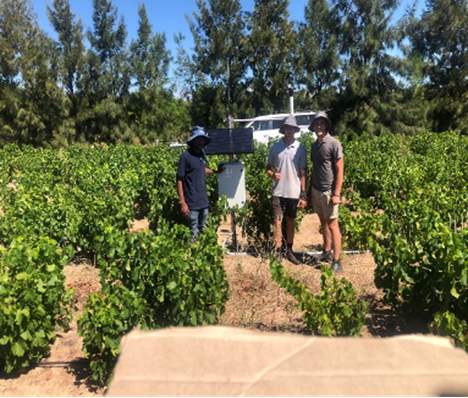






持続可能なイノベーションのための国際パートナーシップ
農業における水利用の改善は、気候変動にうまく適応するために不可欠です。FarmImpact プロジェクトでは、ドイツと南アフリカのパートナーが技術的ソリューションと生態学的アプローチを組み合わせて、南アフリカの西ケープ州におけるワインや果物の栽培の微気候と生産性に対する防風垣の影響を調査します。
南アフリカは、今後数十年で気候変動とそれが農業、ブドウ栽培、果樹栽培に及ぼす悪影響に関して、より大きな課題に直面することになります。アグロフォレストリーシステムは、農業の気候変動への適応に貢献することができます。研究プロジェクト「南アフリカのアグロフォレストリー - 変動する気候下での革新的な土地利用システムの新しい道筋」(ASAP) は、気候変動の影響への適切な対応として、農業地帯に樹木を植えることを目指しています。このプロジェクトは、ドイツ、ナミビア、南アフリカの研究機関と大学間の共同研究プロジェクトを確立するための研究プログラム「SPACES II - 南アフリカの複雑な地球システムプロセスへの適応のための科学パートナーシップ」に貢献しています。このプログラムは、地球システム管理に関する科学的推奨事項の策定に貢献し、この地域の複数の生態系サービスの持続可能な利用を確保することを目的としています。SPACES II は、ドイツ教育研究省 (BMBF) の資金提供を受けています。
農業用水の利用の調査
水不足は、気候変動の影響、人間の脆弱性、生物多様性と生態系機能の喪失とともに、南アフリカにおける最大の課題の 1 つです。特に農業は、顕著な乾期と水不足によって脅かされています。小麦、ワイン、果物の栽培の中心地である西ケープ州は、国の食糧安全保障にとって非常に重要です。これに加えて、南アフリカは長年にわたり、ヨーロッパへの農林産物の主要輸出国となっています。
ドイツ、コットブスのブランデンブルクエネルギー技術センター(CEBra)のマイク・ヴェステ博士とドイツ、ミュンヘベルクのライプニッツ農業景観研究センター(ZALF)のロジャー・ファンク博士は、南アフリカのステレンボッシュ大学植物学・動物学部のケリー・アン・グレイとガイ・ミッドグレイと共同で、ステレンボッシュ地域の柑橘類の果樹園とブドウ園における樹木と作物の相互作用を調査しています。その目的は、発見された環境上の利点を利用して、農業景観に統合する必要がある革新的で多目的な土地利用管理方法としてのアグロフォレストリーシステムの利用を支援することです。したがって、典型的なアグロフォレストリーシステムを体系的に調査し、隣接する一年生作物と永年作物の放射と熱収支に対する樹木の影響を判断します。この文脈では、個々の樹木、防風林、または小規模の森林でさえも、周囲の地表温度に好ましい影響を及ぼし、それが隣接する作物の熱とエネルギーのバランスに特に良い影響を与えます。この目的のために、Apogee Instruments のネット放射計を備えた Campbell Scientific の気象観測所は、微気候測定を実施して、樹木が作物の蒸発散に与える影響を判断し、放射バランスの空間的および季節的な変動を集中的に監視します。
Campbell Scientific 社と Apogee Instruments 社のセンサーによる測定に加え、植物のストレスと光合成能力を評価するために、葉レベルでのガス交換と光合成の測定が数多く行われました。生態生理学的能力とその発達の時間的および空間的モニタリングは、正規化植生指数 (NDVI) と光合成反射指数 (PRI) のスペクトル センサーを使用して測定されます。これらの測定は、それぞれの植生期間中の植物の光合成能力とストレス状態を記録します。ブドウ園での以前の測定では、風速と蒸発散量の減少にプラスの効果があることが示されています。Veste 博士によると、野外のコントロール ステーションを参考にすると、生け垣の樹冠レベル (約 18 m [59.1 フィート]) からの平均風速は、夏の生育期間中に 39% 減少しました。ヴェステ博士によると、十分に灌漑されたブドウに経験的な作物固有の Kc 値を適用すると、夏の成長期間中の蒸発散量は 18.8% 減少しました。現在の調査では、風速、放射バランス、熱ストレスの相互作用に焦点を当てます。風が作物の生理機能と熱ストレスに与える影響に関するデータがさらに収集されます。
樹木防風林の使用は、水の消費量を減らし、ブドウ園、果樹園、農作物畑での節水を促進するのに適したエコエンジニアリング手法です。一方、同様の実験がドイツのミュンヒェベルクで実施されています。これにより、異なる気候条件下での樹木と作物の相互作用を理解し、両大陸の農業システムにおける気候変動に関する科学的交流を促進するための、大陸をまたぐユニークな研究手法が可能になります。
防風垣と灌漑管理
防風帯の主な目的の 1 つは、農作物の水需要を減らすことです。これらの保護帯は、蒸発散特性が異なる多様な圃場エリアを作り出し、それに応じて灌漑の必要性を減らします。灌漑を減らした水需要に適応させるために、FarmImpact プロジェクトのアプリケーションベースのデータベースは、農場の管理者に実際の水使用量と将来の需要に関する情報を提供します。この研究アプローチの斬新な点は、ネットワーク化された微気候測定、ドローンベースのリモートセンシング、風場モデリング、および生態生理学的モデリング (Expert-N) のインテリジェントな組み合わせにあります。その目的は、農業経済評価と最適化された水管理のための確固たる科学的根拠を達成することです。FarmImpact のコンセプトは、新しい科学的方法に基づいて、防風帯を使用して水効率の高い農産物、ワイン、果物を栽培することを目指しています。このような背景から、適応エリアでの実際の灌漑の必要性を予測する Web ベースのソフトウェア ツールの開発は、まったく新しいアプローチです。 2 つの防風帯の間には、通常、風速と蒸発散率の減少が異なるゾーンがあります。Veste 博士によると、現在の天気予報、ゾーンに設置された土壌水分センサーの測定データ、微気候生態生理学的モデリングの結果を統合することで、このツールは特定の農場の実際の灌漑ニーズを正確に予測し、必要に応じて制御可能な灌漑システムに直接リンクすることができます。
持続可能な水と土地の利用
FarmImpact のパートナーは、長年にわたる現場測定に基づいて、地域農業に関する実用的な推奨事項の作成に取り組んでいます。水需要分析と防風垣の最適化されたコンセプトの助けにより、農業業界は水資源をより効率的に使用し、気候変動によってもたらされる将来の課題に生産を適応させることができます。
詳細については、FarmImpact プロジェクトの Web サイトをご覧ください。
ケーススタディの概要
アプリケーション
気候変動への適応場所
南アフリカ、西ケープ州、ドイツ、ミュンヒェベルク使用製品
HFP01-L SN500SS CS655 03002-L CR1000X HygroVue 5 CR800寄稿者
Campbell Scientific Africa (CSAF)計測項目
熱とエネルギーのバランス、葉のガス交換、光合成、風速関連ウェブサイト
SPACES II – Science Partnerships for the Adaptation to Complex Earth System Processes in Southern Africa CLIENT II International Partnerships for Sustainable InnovationsPDFで見る